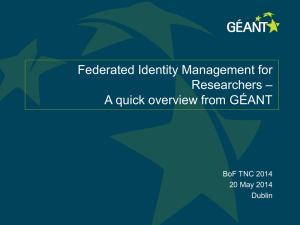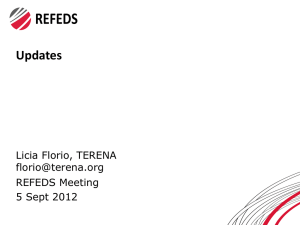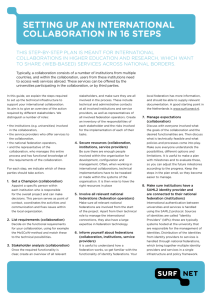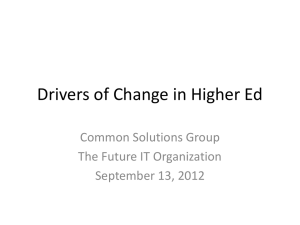European_Identity_Strategy – Nicole Harris
advertisement
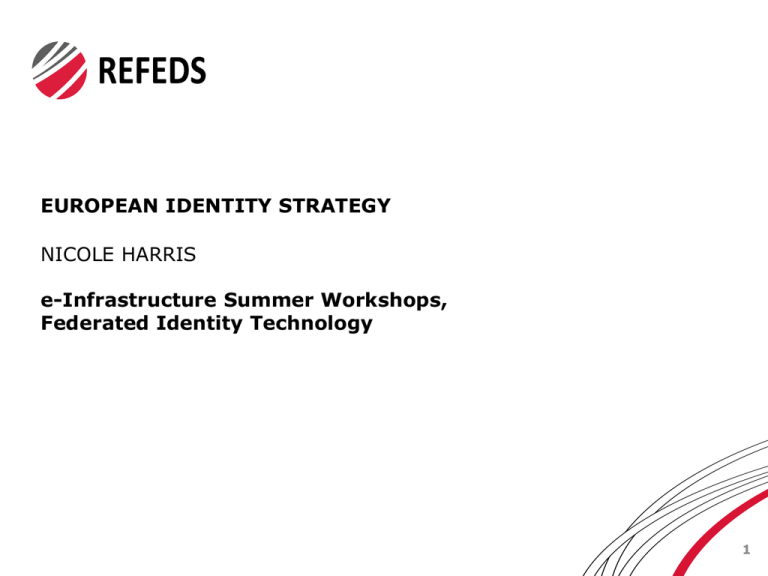
EUROPEAN IDENTITY STRATEGY NICOLE HARRIS e-Infrastructure Summer Workshops, Federated Identity Technology 1 EU DIRECTIVES / REGULATIONS HELPFUL DISTINCTION: A Directive shall be binding, as to the result to be achieved, upon each Member State to which it is addressed, but shall leave to the national authorities the choice of form and methods. A Regulation shall have general application. It shall be binding in its entirety and directly applicable in all Member States. 2 DATA PROTECTION Currently: DIRECTIVE 95/46/EC OF THE EUROPEAN PARLIAMENT AND OF THE COUNCIL of 24 October 1995 on the protection of individuals with regard to the processing of personal data and on the free movement of such data Moving to: REGULATION OF THE EUROPEAN PARLIAMENT AND OF THE COUNCIL on the protection of individuals with regard to the processing of personal data and on the free movement of such data (General Data Protection Regulation). 3 4 “People have really gotten comfortable not only sharing more information and different kinds, but more openly and with more people….That social norm is just something that has evolved over time.” Mark Zuckerberg, January 2011 http://www.guardian.co.uk/technology/2010/jan/11/fac ebook-privacy 5 http://www.oxfordmartin.ox.ac.uk/downl oads/A%20New%20Privacy%20Paradox% 20April%202014.pdf 6 “It is clear that the cord connecting technology and democracy has been severed. This is bad for democracy and bad for technology and it will not be easy to stitch the two back together,” Neelie Kroes, European Commission, March 2014. http://thenextweb.com/eu/2014/03/10/need-stronger-datasafeguards-snowdens-wake-call-says-european-commissioner/ 7 WHAT IS NEW IN DP REGULATION? • A single set of rules on data protection, valid across the EU. • Increased responsibility and accountability for those processing personal data. • Consent has to be given explicitly, rather than assumed. • Easier access to their own data and be able to transfer personal data from one service provider to another more easily (right to data portability). • A ‘right to be forgotten’ will help people better manage data protection risks online: people will be able to delete their data if there are no legitimate grounds for retaining it. • EU rules must apply if personal data is handled abroad by companies that are active in the EU market and offer their services to EU citizens. 8 IDENTITY Currently: DIRECTIVE 1999/93/EC OF THE EUROPEAN PARLIAMENT AND OF THE COUNCIL of 13 December 1999 on a Community framework for electronic signatures. Moving to: Proposal for a REGULATION OF THE EUROPEAN PARLIAMENT AND OF THE COUNCIL on electronic identification and trust services for electronic transactions in the internal Market. 9 WHAT’S NEW? 10 REFEDS Goals Forum for R&E Federations Operators and other parties: To develop best practise to facilitate inter-federations; Following the model: do it once, use it multiple times. Hopefully to offer a place for user-communities to put forward their requirements/complaints. 11 Last update May 2014 31 Production Federations 17 Pilot Federations 12 REFEDS RESOURCES • DISCOVERY GUIDE (SEE NEXT SLIDE) • FEDERATION POLICY GUIDELINES WITH GEANT • FEDERATION OPERATIONAL BEST PRACTICE • ENTITY CATEGORIES TO SUPPORT DATA RELEASE • STANDARDS AND SPECIFICATIONS: • METADATA QUERY PROTOCOL • SAML ENTITY CATEGORIES • SERVICES 13 DISCOVERY.REFEDS.ORG 14 HOW?? http://www.terena.org/publications/files/2012 -AAA-Study-report-final.pdf 15 AARC CALL › GÉANT preparation is on-going: › Horizon › Led heavily 2020 by callNRENs on AAI: ›› Open Calls and Enabling usersand helpe-Researchers support Consortium with both NRENs use-cases › community Good opportunity to work together as a team ›› Horizon call on Some of2020 the work willAAI: take place in REFEDS › Consortium with both NRENs and e-Researchers but funded › Good opportunity to work together as a team › Main topics: › Some of the work response, will take place in REFEDS › LoA, Incident training and but funded outreach, attribute authorities 16 REFEDS EINFRA Call Policy Best Practises Operational Practises LoA Federation Harmonisation Training on policies Identity Harmonisation Services eduGAIN Proof of Concepts Pilot Services Outreach Support for R&E communities GÉANT Supporting Tools Guest IdPs Moonshot eduroam Research Work Enabling Users 17 Research use-cases, tools and services NICOLE HARRIS e-Infrastructure Summer Workshops, Federated Identity Technology 18 FIM4R: Federated Identity Management for Researchers • Includes photon & neutron facilities, social science & humanities, high energy physics, climate science, life sciences and ESA • Aim: define common vision, requirements and best practices • Vision and requirements paper published:https://cdsweb.cern.ch/record/1442597 “A common policy and trust framework for Identity Management based on existing structures and federations either presently in use by or available to the communities. This framework must provide researchers with unique electronic identities authenticated in multiple administrative domains and across national boundaries that can be used together with community defined attributes to authorize access to digital resources.” 19 What do Researchers Want? • A log-in! • Everyone of their researcher partners to have a log-in. • Personally Identifiable Information (PII) to be released – where they need it. • Attributes from multiple sources. • To be able to have a higher level of trust (assurance). • Non-web login. • Great user interface. • Unicorns. 20 30+ Research Infrastructures in Europe Countless more “long tail” users Attribute aggregation User friendliness Credential translation Attribute release Levels of Assurance Homeless users Bridging Communitie s Non-webbrowser Three Collaborative Pilots – User communities and GÉANT “A connected network of people, information, tools, and methodologies for investigating, exploring and supporting work across the broad spectrum of the digital humanities.” “Basic life science information constitutes a testament of human and natural evolution and advancement. As such, this wealth of knowledge should be freely available for all to access, study and process” “Umbrella is the Federated Identity Solution of the Photon and Neutron Community, enabling user initiated transfacility access.” 22 DARIAH EXPERIENCE eduGAIN is the best approach to pan European AAI for DARIAH but some time is needed to fulfil all needs DARIAH would like to see more entities available in eduGAIN and reasonable attributes available DARIAH has been able to meet many requirements • Distributed user and privilege administration • Policies that allow for integration into DFNAAI and eduGAIN Combination of eduGAIN and community specific • DARIAH homeless-IdP and attribute authority 23 ELIXIR EXPERIENCE Next phase of AAI in ELIXIR – blueprint for discussion • External IdPs via eduGAIN • ELIXIR specific services for authorisation (REMS), non web, homeless users and community management Federated identity cross sector collaboration: REMS to be used by FI-CLARIN & FICESSDA A pan-European approach to LoA would be appreciated/necessary in the future • Minimise ELIXIR-specific customisation 24 UMBRELLA Experience More opportunities for NREN/Research Infrastructure Collaboration • Security analysis discussion at FIM4R Piloting with a wider community has benefits • JANET/Diamond Light in UK Moonshot Pilot Confidentiality aspects critical for Umbrella high competition, especially structural biology • Authorisation is delegated to the systems participating in Umbrella 25 WORK TO DO Attributes - Release, consistency, community specific and harmonisation Levels of Assurance A long term issue to be broken down Understanding security and incident response Progress can be slow initially More experience, work faster Non web – Early pilot not novice user but evolving more Many other research communities developing AAI requirements and work 26 Opportunities FIM4R /RDA T&I Committee Increased EC/public awareness of security Federations looking to do more • Support of GÉANT Code of Conduct • Emerging ‘opt-out’ pilots for eduGAIN • REFEDs Federation Operator Best Practicecommunities services Research appearing in national federations and eduGAIN • Knowledge gained with these pilots helps support other communities & plan service 27 FIM: THE BUSINESS CASE NICOLE HARRIS e-Infrastructure Summer Workshops, Federated Identity Technology 28 WHY? Developing a business case forces a wellconsidered decision that assesses a range of options. Managing a business case throughout an undertaking supports successful implementation by keeping activities "on course" for the desired outcome. 29 EXAMPLES – UK FEDERATION • PILOT FEDERATION: 2003 – 2006. • Development programmes with institutions including “early adopter” funding. • FULL FEDERATION from 2006. • 1997 Entites with the federation. • 953 Identity Providers. • 1047 Service Providers. 30 31 32 33 34 SECTIONS OF A BUSINESS CASE STRATEGIC FIT OPTIONS APRAISAL AFFORDABILITY ACHIEVABILITY 35 STRATEGIC FIT 36 STRATEGIC FIT – THE QUESTIONS • Are access management requirements currently being met? • Why do we have to change and does it have to be done now? • What internal and external strategic drivers are there for change? • Does the change fit with institutional strategy? • What is our approach to open-source and community-supported technology? • To what extent should identity information be controlled within the institution? • How many services should be brought together under a single access management infrastructure? 37 (NOT) THE KILLER APP 38 STRATEGIC DRIVERS - EXAMPLES 39 STRATEGIC DRIVERS – INFLUENCES (1) INTERNAL DRIVERS EXTERNAL DRIVERS 40 STRATEGIC DRIVERS – INFLUENCES (2) INTERNAL DRIVERS EXTERNAL DRIVERS 41 STRATEGIC DRIVERS – INFLUENCES (3) INTERNAL DRIVERS EXTERNAL DRIVERS 42 OPTIONS APPRAISAL 43 OPTIONS APPRAISAL – THE QUESTIONS • What options are there? • Is the range of options under consideration sufficiently broad? • Have innovative options and/or collaboration with others been considered? • What are the option criteria? • Are all benefits, costs, risks and timescales covered? • Are all business needs, requirements and characteristics covered? • Would other stakeholders agree with the option criteria? • Are criteria weightings necessary? • What benefits, costs, risks and timescales are associated with each option? • What option has the optimum balance of cost, benefit and risk? • What trade-offs need to be made? (eg foregoing some of the benefits to keep costs within budget) 44 STRATEGIC CHOICES DO NOTHING DEPLOY A LIMITED SOLUTION DEPLOY A SINGLE SSO SOLUTION 45 DEPLOYMENT CHOICES OPEN SOURCE SOFTWARE IN-HOUSE COMMUNITY SUPPORT OPEN SOURCE SOFTWARE IN-HOUSE PAID-FOR SUPPORT COMMERCIAL SOFTWARE / MANAGED SERVICE COMMERICAL / MANAGED SERVICE SUPPORT DO IT YOURSELF NOT RECOMMENDED! 46 Hub and Spoke? Mesh Federation? Edugate JAGGER 47 COST / BENEFITS ANALYSIS: BENEFITS 48 COST / BENEFITS ANALYSIS: COST • UPFRONT PROJECT COSTS: pre-requisites, development effort, direct costs (hardware etc.), training, legal advice. • ONGOING SERVICE COSTS: membership fees?, support costs, administrative costs, hardware replacement, audit and compliance. • OPPORTUNITY COSTS: what other projects or initiatives could be undertaken if the budget or staff allocated required for the option could be freed up? WE CANNOT TELL YOU HOW MUCH THIS IS GOING TO COST TO DEPLOY, SORRY 49 AFFORDABILITY 50 Affordability • Is the required budget available to deliver the whole project? − − − − What budget(s) will be used? Is this capital or operating expenditure, or both? It the funding available and secure? Is there any contingency? • If not, can the budget be obtained? − Can the scope be reduced or delivered over a longer period? − Could funding be sought from other sources? • What is the cost of not pursuing the preferred cost of action? • What other plans and activities are dependent on it? 51 Cost of an IdP 52 ACHIEVABILITY 53 ACHIEVABILITY QUESTIONS (1) • Is the organisation ready for the change? − Are the pre-requisites in place and dependencies being managed? − If not, what needs to be done? • Can the change be achieved with current capability and capacity? − Are the necessary skills and experience available to assign to the project? − Is the organisation able to manage and achieve a technology-enabled change project? − Is there a successful track record of such projects? − Is there an appetite and organisation culture for the required change? − Is there senior management leadership and commitment for the change? − Is the project sponsor fully committed and are the stakeholders “on board”? − Is there an understanding of and agreement on what will constitute success? 54 ACHIEVABILITY QUESTIONS (2) If no: • How can the required capability and capacity be acquired? • Can the risks be managed? − Are stakeholders content with the residual risk? − Can another option be implemented if the preferred option fails? • Does the scope or timescale need to be changed? 55 56 TITLE 57 TITLE 58 TITLE 59
